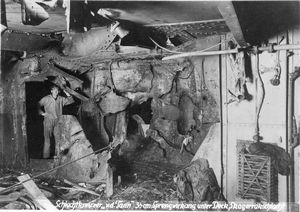Catalogue number 118052
Damage to S.M.S. von der Tann, Battle of Jutland
During the Battle of Jutland (Skagerrakschlacht in German), on 31st May, the German battlecruiser von der Tann (commissioned 1910) was hit four times by heavy-calibre shells fired by the British 5 Battle Squadron (first hit by H.M.S. Barham, then two from H.M.S. Tiger and finally one from H.M.S. Revenge). This photograph shows the damaged caused by the explosion of the first 13.5-inch shell from H.M.S. Tiger. The plunging shot penetrated the outer deck passing through the battery deck, a bulkhead and a horizontal bulkhead before exploding. The torn edges of the hole in the battery deck, with light coming in, can be seen directly above the sailor, at the top of the photograph. Extensive damage was made to the barbette of C turret which was out of action for the rest of the engagement. We can see the cracked and splintered armour around the hole in the turret base, center of the photograph. Debris prevented the turret from turning and we can see the efforts of the damage control party to free the jammed turret from the shattered barbette - a rope pulls back torn metal, above this, a rope has been tied around a metal beam and part of the barbette to free it from the turret base.
Recto: “Battlecruiser v.d. Tann effect of an exploding 34cm shell belowdecks, Battle of the Skagerrak” in German and in black ink
14cm x 10cm Matt gelatin silver print
|
 |